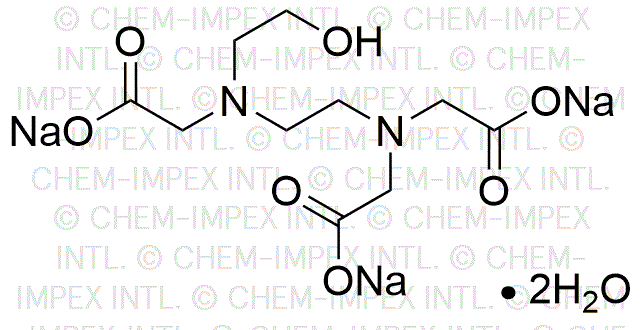Trisodium N-(2-Hydroxyethyl)ethylenediamine-N,N',N'-triacetate dihydrate is widely utilized in research focused on:
- Metal Ion Chelation: This compound effectively binds to metal ions, making it valuable in analytical chemistry for removing unwanted metal contaminants from samples, which is essential in environmental testing and quality control.
- Pharmaceutical Formulations: Its chelating properties are beneficial in drug formulations, enhancing the stability and bioavailability of active pharmaceutical ingredients, particularly in intravenous medications.
- Biochemical Research: Commonly used in laboratories, it serves as a buffer and stabilizer in biochemical assays, helping maintain pH levels and enzyme activity during experiments.
- Cosmetic Products: The compound is incorporated in skincare formulations to improve product stability and enhance the efficacy of active ingredients, making it popular in the cosmetic industry.
- Industrial Cleaning Agents: Due to its ability to bind hard water ions, it is used in various cleaning products, improving their effectiveness in removing stains and residues in industrial settings.
General Information
Properties
Safety and Regulations
Applications
Trisodium N-(2-Hydroxyethyl)ethylenediamine-N,N',N'-triacetate dihydrate is widely utilized in research focused on:
- Metal Ion Chelation: This compound effectively binds to metal ions, making it valuable in analytical chemistry for removing unwanted metal contaminants from samples, which is essential in environmental testing and quality control.
- Pharmaceutical Formulations: Its chelating properties are beneficial in drug formulations, enhancing the stability and bioavailability of active pharmaceutical ingredients, particularly in intravenous medications.
- Biochemical Research: Commonly used in laboratories, it serves as a buffer and stabilizer in biochemical assays, helping maintain pH levels and enzyme activity during experiments.
- Cosmetic Products: The compound is incorporated in skincare formulations to improve product stability and enhance the efficacy of active ingredients, making it popular in the cosmetic industry.
- Industrial Cleaning Agents: Due to its ability to bind hard water ions, it is used in various cleaning products, improving their effectiveness in removing stains and residues in industrial settings.
Documents
Safety Data Sheets (SDS)
The SDS provides comprehensive safety information on handling, storage, and disposal of the product.
Product Specification (PS)
The PS provides a comprehensive breakdown of the product’s properties, including chemical composition, physical state, purity, and storage requirements. It also details acceptable quality ranges and the product's intended applications.
Certificates of Analysis (COA)
Search for Certificates of Analysis (COA) by entering the products Lot Number. Lot and Batch Numbers can be found on a product’s label following the words ‘Lot’ or ‘Batch’.
*Catalog Number
*Lot Number
Certificates Of Origin (COO)
This COO confirms the country where the product was manufactured, and also details the materials and components used in it and whether it is derived from natural, synthetic, or other specific sources. This certificate may be required for customs, trade, and regulatory compliance.
*Catalog Number
*Lot Number
Safety Data Sheets (SDS)
The SDS provides comprehensive safety information on handling, storage, and disposal of the product.
DownloadProduct Specification (PS)
The PS provides a comprehensive breakdown of the product’s properties, including chemical composition, physical state, purity, and storage requirements. It also details acceptable quality ranges and the product's intended applications.
DownloadCertificates of Analysis (COA)
Search for Certificates of Analysis (COA) by entering the products Lot Number. Lot and Batch Numbers can be found on a product’s label following the words ‘Lot’ or ‘Batch’.
*Catalog Number
*Lot Number
Certificates Of Origin (COO)
This COO confirms the country where the product was manufactured, and also details the materials and components used in it and whether it is derived from natural, synthetic, or other specific sources. This certificate may be required for customs, trade, and regulatory compliance.


